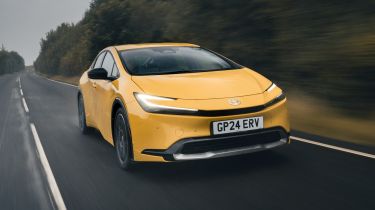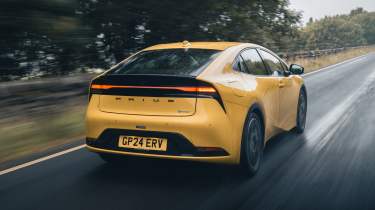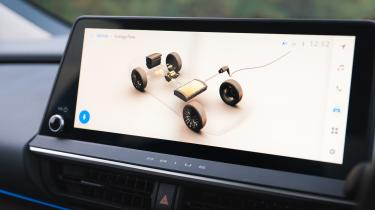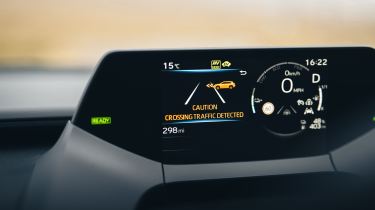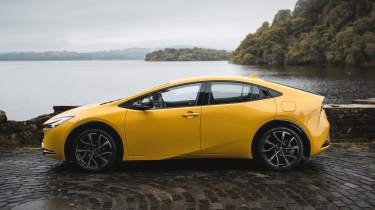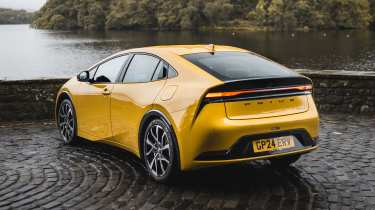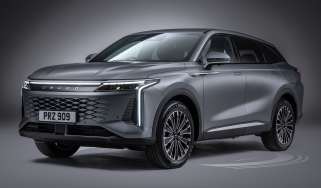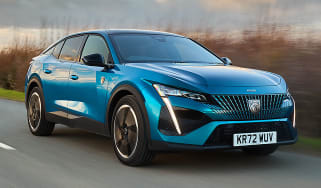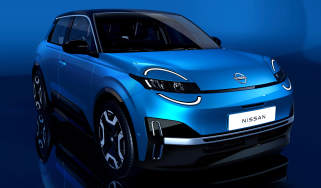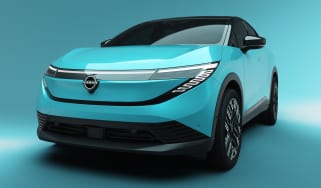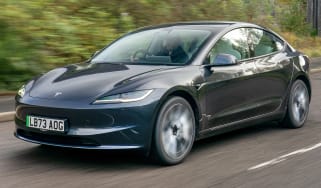Toyota Prius review – desirable and efficient, but lacks boot space
“The Toyota Prius has a new-found air of desirability and it’s good to drive, but it’s expensive and not very practical”
Pros
- Fun to drive
- Sleek design
- Efficient
Cons
- Small boot
- Lack of headroom in the rear
- Expensive
Verdict – is the Toyota Prius a good car?
The Toyota Prius has shed its Uber image to become a desirable, stylish family car with an excellent plug-in hybrid engine. It offers a compelling mix of efficiency and fun, outperforming key rivals in both areas. While it’s not the most practical or affordable choice, its strengths make up for these drawbacks, earning it the Carbuyer Best Plug-in Hybrid award for 2025.
Toyota Prius models, specs and alternatives
The Toyota Prius was a car that was way ahead of its time when it first launched over 30 years ago. It was the first hybrid car to hit the mainstream, combining petrol and electric power to improve fuel efficiency. These days, hybrid tech is commonplace and can be found in many of Toyota’s models, including the Corolla, C-HR and Yaris. With those models already on sale, the Japanese brand didn’t think it was worth bringing the new Prius to the UK after the old model was discontinued in 2022.
Now, though, Toyota has taken a U-turn and decided to bring the latest fifth-generation model to the UK – this time solely as a plug-in hybrid.
Over the years, previous generations of the Toyota Prius became staples of Uber and taxi fleets thanks to their ability to return great fuel economy and low running costs. The Corolla and Corolla Touring Sports hybrid models have since replaced it in that role, and Toyota says it’s targeting private buyers with the latest Prius this time around. This time it costs from £37,000, which is around £5,000 more than the previous plug-in hybrid Prius.
Right off the bat, the latest Prius makes a much better impression than previous iterations with a design we think will be more appealing to the average buyer. It features much less fussy styling than the version that came before it and is almost coupe-like in design. At the front the Prius gets C-shaped headlights that are in line with the styling of other models like the C-HR, while the rear end features a full-width light bar surrounded by black trim for an almost retro look. Overall the Prius’ design is swoopier and smoother than that of its angular predecessor.
More reviews
The latest Prius is offered in just two trim levels; the entry-level model is called ‘Design’, while top-spec models are known as ‘Excel’ like many other model trims in the Toyota family. Toyota reckons the majority (around 70%) of sales will comprise the Design models.
|
Trim levels |
Power options |
|
|
MPG, running costs & CO2 emissions
The latest Toyota Prius is offered as a plug-in hybrid only, rather than being a self-charging hybrid like the majority of its predecessors. That means it has a rather lofty mpg figure and will need to be periodically charged up, so is likely only to make sense if you have access to a home wallbox charger or another means of keeping it topped up.
The benefit to its plug-in hybrid system is that it can run on electricity alone for longer periods of time compared to a traditional hybrid. The official electric range in the Prius is up to 53 miles to a charge in Design specification, but the larger wheels fitted to Excel models reduce this to 44 miles.
|
Model |
Fuel economy |
CO2 emissions |
|
Toyota Prius |
565mpg |
12g/km |
How efficient is the Toyota Prius in the real world?
During our time with the Toyota Prius, we were very impressed by its fuel economy. When driving in the normal ‘Hybrid’ mode, the Prius easily returned over 85mpg, never dropping below 80mpg throughout our testing. Sure, that’s not quite as astronomical as the quoted 565mpg figure, but we were driving in a mixture of environments using both the petrol engine and electric motor. From our experience, 85mpg is an admirable figure for a plug-in hybrid.
The Prius continued to impress when we selected the electric-only mode. Efficiency was actually better than its on-paper figures – we were able to do 4.3 miles per kWh, which translates to an electric range of 58 miles. The Prius comes with a heat pump as standard, too, which helps condition the battery and keep it at optimal operating temperatures in colder weather conditions to help preserve range.
How much will the Toyota Prius cost in tax?
Because the Prius is a plug-in hybrid and can run on electric power more often, it has a low CO2 emissions figure of just 12g/km and therefore sits in a very low Benefit-in-Kind (BiK) band, making it a great choice as a company car. Its status as an alternative-fuel vehicle also means it qualifies for an annual VED (Road Tax) at the discounted rate of £180 per year at the time of writing.
Design and Excel models both start from less than £40,000, too, meaning it won’t incur the luxury car tax surcharge from years two to six, but be aware that if you add any options to tip that price over the threshold, you’ll have to pay it.
What will the Toyota Prius cost to insure?
The Toyota Prius gets a surprisingly high insurance group rating of 31 out of 50. We suspect this could be due to its advanced hybrid system, relatively high power output and the fact that it’s a popular car for commuters in cities and urban environments, which can increase the likelihood of a crash.
Engines, drive & performance
Fuel efficiency has always been the order of the day for the Toyota Prius, but the new model aims to be quicker and more fun to drive than before. Language used in Toyota’s press material includes words like ‘agility’ and ‘responsiveness’ to describe the Prius, so these have been a focus for the model.
Once you sit in the driver’s seat of the Prius, you’ll notice the small steering wheel and a small, futuristic driver’s display above. The display sits close to the windscreen so as to make it easier to keep your eyes on the road, a bit like Peugeot’s driver-focused i-Cockpit setup. It gives the driving position a sporty feel, which we like.
The drawback is that the driving position is set quite far back from the windscreen. We found the deep dashboard created some blindspots that became noticeable when pulling out of junctions and when parking. Rearward visibility also isn’t great, which doesn’t help with parking, but at least you get a reversing camera.
On the move, you have a few driving modes to choose from. ‘Hybrid’ is the default option and is the best for everyday driving – the onboard computer will decide when’s best to use electric or petrol power. There’s ‘Eco’ for better efficiency, ‘Power’ for a bit more oomph, ‘EV’ for fully electric driving, and ‘Charge’ which keeps the battery topped up while driving.
That’s all well and good, but has Toyota made the Prius any more fun to drive than before? We certainly think so – the plug-in hybrid system is punchy and the Prius feels more than capable of dealing with that power. Body lean is kept to a minimum through the corners and as a result it feels rewarding on twisty country roads.
But at the end of the day, the Prius isn’t a sports car. Most buyers will use it for pootling around town, and thankfully it works well here, too. The heavy steering might take a bit of getting used to, but we found it to feel weighted to our tastes, even if there’s not a whole lot of feedback through the steering wheel. Comfort is definitely a plus point, because even at low speeds the Prius soaks up potholes and road imperfections with ease.
It’s also very refined when you take it on the motorway. There’s little wind noise thanks to its aerodynamic shape, and the supple and supportive seats make long distance cruising a comfortable experience. We did notice some road noise from the Prius’ eco-friendly tyres, but overall, things are pretty serene.
If you ask for extra shove and the combustion engine kicks in, it does let out a momentary gruff noise, but at a steady cruise this isn’t a problem. Importantly, the transition between electric power and the combustion engine feels very smooth.
Plug-in hybrid models
This time around there’s no self-charging version of the Toyota Prius – instead, the plug-in hybrid system is the only option. It uses a 150bhp 2.0-litre four-cylinder engine combined with a 161bhp electric motor for a total output of 223bhp.
Impressively, that’s over 100bhp more than the old Prius PHEV. For context, a 223bhp figure puts the Prius in the same ballpark as some hot hatchbacks in pure power terms. A sub-seven-second 0-62mph time is pretty quick, too – quicker than a Honda Civic or a Volkswagen Golf eHybrid.
|
Model |
Power |
0-62mph |
Top speed |
|
Toyota Prius |
223bhp |
6.8 seconds |
110mph |
Interior & comfort
There’s been a big step up in quality for this generation of Toyota Prius and everything feels well nailed-down and solid. That said, there are still some cheaper, harder plastics used in certain areas, but the points you’ll touch most often are, at least, made of higher quality materials. One area in the old Prius that let down the interior quality was its gear selector – this time it’s a piece that you’ll also find in many premium Lexus models, which is finished in a leather-like material.
Is the Toyota Prius’ infotainment and sat-nav system easy to use?
The driver’s display is pushed very far forward to the base of the windscreen in the Prius which makes it easy to see over the small steering wheel and means it’s easy to keep your eyes on the road. We much prefer this setup to the comparable Peugeot i-Cockpit setup and we think most buyers will agree, whereas the i-Cockpit is more Marmite.
We love the Prius’ new 12.3-inch infotainment screen – it’s much more pleasing to use than the old model’s system, it’s responsive to your inputs, submenus are easy to navigate and the system feels quick to load. It’s not perfect though – we wish the on-screen buttons were a little bigger so they were easier to click on the move.
Thankfully, the climate controls are physical buttons – Toyota hasn’t moved them to the touchscreen like many of the Prius’ rivals. They’re simple buttons, but that means they work perfectly and are refreshingly easy to use for a modern car.
While the Prius does get a reversing camera, it’s a shame there’s no option for a 360-degree camera because rearward visibility is poor.
Key features | |
|
Design
|
Excel (Design plus…)
|
Boot space, practicality & dimensions
While the design focus on aerodynamics has led to great efficiency and sleek, low-slung styling for the latest Prius, the downside is that the low roofline comes at the expense of some practicality and interior space. It’s also longer than many competitors which could make it harder to park.
Up front there’s plenty of space for the driver and passenger in terms of elbow, leg and headroom, but in the rear the Prius falls short – that’s surprising considering how the old Prius was a favourite with taxi drivers. There’s not much headroom back there, so six-foot tall adults could find it claustrophobic, but there’s at least decent amount of legroom. A high window line means the Prius doesn’t feel particularly light and airy to sit in. Useful touches include ISOFIX points as standard in the rear, so buyers with young children can easily fit child seats.
|
Size comparison | |||
|
Model |
Length |
Width |
Height |
|
Toyota Prius |
4,599mm |
1,782mm |
1,430mm |
|
Volkswagen Golf eHybrid |
4,284mm |
1,789mm |
1,476mm |
|
Peugeot 308 PHEV |
4,367mm |
1,852mm |
1,441mm |
|
SEAT Leon e-Hybrid |
4,368mm |
1,800mm |
1,442mm |
Does the Toyota Prius have a big boot?
The Toyota Prius has a small 284-litre boot so you may need to reconsider if you’re a buyer looking for a car to regularly transport large items or luggage. The plug-in hybrid version of the Peugeot 308, for example, boasts a more generous boot capacity of 361 litres.
Still, 284 litres is a significantly larger boot capacity than the old plug-in hybrid Prius, and it’s more space than you get in the Volkswagen Golf eHybrid. Plus, there’s no load lip, which makes lifting heavy items into the boot easier.
|
Boot space comparison | |
|
Model |
Boot space |
|
Toyota Prius |
284 litres |
|
Volkswagen Golf |
273 litres |
|
Peugeot 308 PHEV |
361 litres |
|
SEAT Leon e-Hybrid |
270 litres |
Reliability & safety
Toyota has long been known for producing reliable cars and the brand offers a market-leading warranty to back that up; keep your Toyota serviced every 12-months or 10,000 miles by a main dealer and your warranty continues for up to 10 years or 100,000 miles. Safety is yet to be proven given the Prius still needs to be tested by Euro NCAP, but its list of safety tech is reassuring.
While the Prius itself is too new to have featured in the list of the top 50 models, Toyota came in an impressive eighth place out of 32 manufacturers in the latest 2024 Driver Power customer satisfaction survey. Buyers consider the brand’s cars good value for money, built to a high quality, good to drive and to have low running costs. Interior quality is less well-received, and Toyotas are not considered the most practical cars on the market. Just 18.1% of buyers reported an issue with their Toyota in the first year, which is much lower than average.
How safe is the Toyota Prius?
The Toyota Prius is expected to be a very safe car, although it’s yet to be tested by Euro NCAP. It gets all the usual safety kit expected of a modern car, whether you go for the Design or Excel specification. This includes pre-collision warning, adaptive cruise control, lane-change assist, lane-departure warning and proactive driving assist. The latter applies gentle braking and steering force into curves and when nearing pedestrians, cyclists and other road users to avoid collisions.
Should you buy a Toyota Prius?
You should definitely consider buying a Toyota Prius if you’re in the market for a plug-in hybrid. It’s an improvement over its predecessor in terms of efficiency, quality and driver appeal, and it finally has the style to stand out, too. We’d only advise against buying the Prius if you need something with a big boot and spacious rear seats.
What is the Carbuyer pick of the Toyota Prius range?
The Toyota Prius lineup is very simple given it has just the one powertrain option and two trim levels. It’s gone up in price, though, so we’d stick with the entry-level Design model because aside from the fancy leather seats in Excel, there’s not a great deal more thrown in that you necessarily need. It’s also worth considering the fact that the larger 19-inch alloy wheels on Excel cut the on-paper electric range by nine miles.
Toyota Prius alternatives
The Prius’ closest competitor, the Hyundai Ioniq, was discontinued a few years ago, but plenty of PHEV versions of well-known hatchbacks have cropped up in recent years which are definitely worth your consideration.
How we tested the Toyota Prius
We tested the Toyota Prius in September 2024 on UK roads in Excel trim.
Which Is Best?
Cheapest
- Name2.0 PHEV Design 5dr CVT
- Gearbox typeAuto
- RRP£37,785
Most Economical
- Name2.0 PHEV Design 5dr CVT
- Gearbox typeAuto
- RRP£37,785
Fastest
- Name2.0 PHEV Design 5dr CVT
- Gearbox typeAuto
- RRP£37,785
